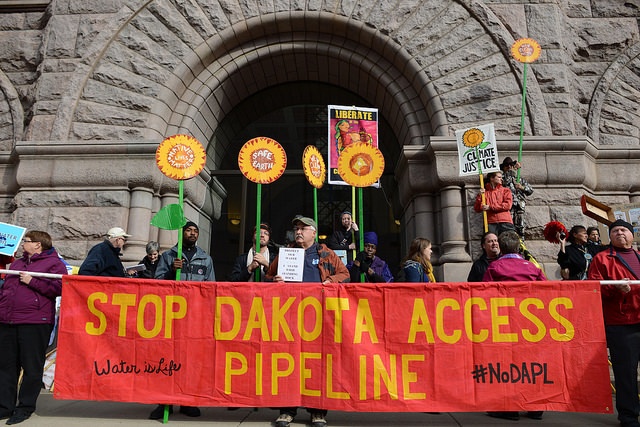By Carol Pierson Holding
Quick: Name the industry that has the most to lose from climate change.
Reuters would argue it’s the insurance industry, as they did in their February 9th article “Extreme Weather Batters The Insurance Industry.” But the “industry” doesn’t just mean insurance companies. It’s any insurer—even the US government.
 The government entered the insurance market after a catastrophic weather event in 1965, when “Billion Dollar Betsy” took 75 lives and a billion dollars worth of property—the most in any natural disaster up to that point. Insurance companies raised their property rates to compensate for future weather risks that had thus far been unimaginable. Consumers howled. Congress responded with the National Flood Insurance Program (NFIP), offering affordable insurance.
The government entered the insurance market after a catastrophic weather event in 1965, when “Billion Dollar Betsy” took 75 lives and a billion dollars worth of property—the most in any natural disaster up to that point. Insurance companies raised their property rates to compensate for future weather risks that had thus far been unimaginable. Consumers howled. Congress responded with the National Flood Insurance Program (NFIP), offering affordable insurance.
Everyone loved blaming the insurance companies for not providing “affordable” insurance. But what they did was what they’re paid to do: set rates based on risks. They asked people who build or buy or rent in places that are at high risk for damage from floods to pay more, which was the only way insurers could protect the reserves they hold for future catastrophes.
But it was 1965 and US leaders did not realize that weather might be becoming more extreme. They figured insurance companies were being predatory. And so NFIP was established to provide government insurance.
This fund was contingent on risk mitigation measures managed by the local communities. But most of these measures were never implemented.
Because NFIP has charged below-market rates for  40 years, they were left with woefully inadequate reserves from which to pay losses. After Katrina and other hurricanes, NFIP is now faced with a staggering $19 billion deficit.
40 years, they were left with woefully inadequate reserves from which to pay losses. After Katrina and other hurricanes, NFIP is now faced with a staggering $19 billion deficit.
The craziest thing is that, because below-market flood insurance is available, builders can continue to build on floodplains because they bear no risk. If a flood damages their property, the NFIP will make them whole. Think of the houses and apartments on the water in Florida and along the Mississippi River. Some have been destroyed and rebuilt six times, all courtesy of NFIP and the U.S. taxpayer. Mortgage lenders exacerbate the trend, requiring NFIP insurance on any property in a flood zone.
Worst of all are the environmental costs. As the NYU Institute for Policy Integrity reports in "Flooding the Market", “The financial costs of the NFIP are considerable, but they are likely dwarfed by the ecological damages that the program encourages. Floodplains are located near waterways and in coastal zones. These areas tend to be both ecologically significant and sensitive, and they contribute substantial ecosystem services.”
Now, some insurers, especially those that are European-based, not only accept climate change but also incorporate it into their risk assessment and pricing. And this is not new: in the 1980s, when Americans who believed in saving the environment were sometimes called “kooks” and “tree-huggers,” the staid business of US property insurers started charging companies for potential environmental hazards in anticipation of EPA fines and consumer lawsuits, effectively putting a price on environmental degradation.
So how do we get developers to stop building on floodplains? And what happens now with flood insurance? Insurers have formed a group called SmarterSafer, which includes environmental groups, taxpayer advocates, emergency management organizations, insurance companies and others. SmarterSafer is demanding that Congress, as it struggles to fix NFIP, undertake reforms like creating better maps of floodplains, using risk-based pricing of insurance premiums in all cases, tightening building regulations for these floodplains and enforcing the laws. They also want subsidies for disadvantaged homeowners to be made explicit and separated from the cost of insurance, focusing funding on helping the poor rather than vacation home developers. A congressional hearing is scheduled for March 9 to decide on a five-year reauthorization for NFIP that would split subsidies from insurance.
What is depressing, but not surprising, is that many of the insurers behind SmarterSafer — Allianz, SwissRe, Zurich — are European re-insurers, which were barred from participating in NFIP by virtue of being re-insurers. And of course, these companies are at the top of CSRHUB’s insurance industry rating — see the insurance industry list here. The SaferSmarter coalition has a few US companies—Chubb, Liberty Mutual and USAA—but they aren’t rated as highly. Maybe they’ve just got some catching up to do.
Carol Pierson Holding is a writer and an environmentalist; her articles on CSR can be found on her website.
Photos Inset: Creative Commons courtesy of NASA's Marshall Space Flight Center and News Muse, respectively.


